Instructions for caring for Pavlovsk lemon at home
Growing lemons at home is a fun activity that makes you feel like a real gardener. With the right choice of variety and care, the plant will bloom and bear fruit even in a pot. In this case, it is not necessary to have a separate room equipped with instruments to create the necessary conditions. You can grow a lemon tree on your windowsill at home.
Pavlovsk lemon is the most popular among citrus growers. This is one of the oldest varieties grown on windowsills in our country. It is distinguished by its compactness, stable and long-term fruiting, and ease of crown formation. Read on to learn about growing and caring for Pavlovsk lemon at home.
General description of the variety
Pavlovsk lemon is one of the oldest varieties brought to Russia. Such plants may vary slightly in some characteristics. After all, over many years of growing them at home, they have been subjected to selection more than once.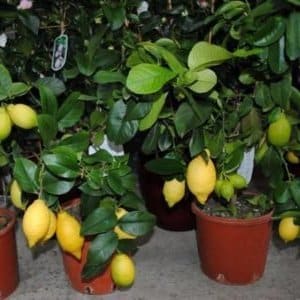
Twigs of this lemon Ivan Semenovich Karachistov first brought Pavlov to his relative Elagin from Turkey to the city. This happened in the 60s. XIX century.
Elagin rooted the cuttings, grew lemon trees from them and began distributing the branches to friends and acquaintances. Soon the exotic plant spread not only throughout Pavlov, but throughout Russia. The name Pavlovsk lemon was given in honor of the city to which it was brought.
In 1937, a lemon nursery was established on the outskirts of Pavlov.Thanks to the efforts of Soviet breeders, it was possible to achieve long-term fruiting of the variety in conditions of lack of light and obtain a pleasant taste of the fruit.
Main characteristics
Pavlovsk lemon is one of the most popular varieties grown at home. He is short in stature and does well in an apartment.
Description of Pavlovsk lemon:
- Crown. Pavlovsk lemon is more of a bush than a tree. Its height reaches 0.8-1.5 m. It usually has from 2 to 4 trunks. The branches are strong, not very thick, drooping. Young shoots are smooth and green, old branches have a grayish tint and are covered with cracks. The plant has long spines. The crown is round in shape. Its maximum diameter reaches 1 m.
- Leaves. Large, bright green with a glossy sheen. Pavlovsk lemon leaves have oval, round, ovoid and elongated shapes. The maximum width of an adult leaf blade reaches 8 cm, and the length is 15 cm. The petioles are shortened. The life cycle of one leaf is 3 years.
- Bloom. Most cases are observed in September and March. The inflorescences consist of 2-6 flowers of a white or light lilac hue. The diameter of one flower reaches 2-3 cm. Of all the blossomed buds, no more than 17% of the ovaries remain on the plant. The first flowering is observed 3-4 years after planting. If the lemon blooms earlier, the buds are cut off.
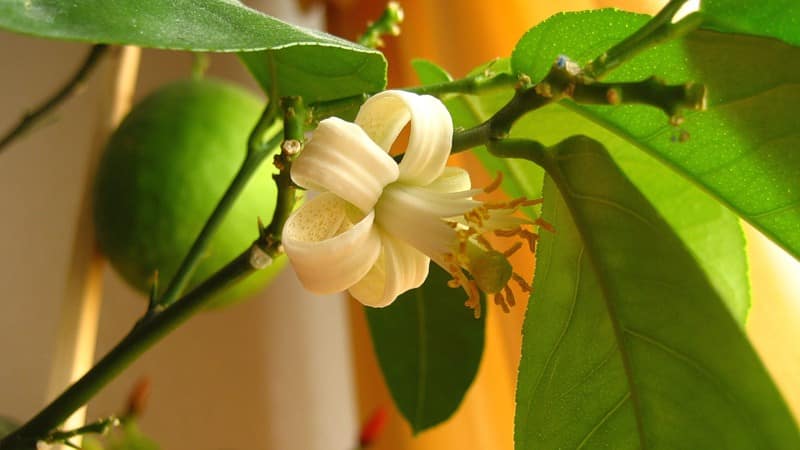
- Fruiting. Occurs 3-4 years after planting. From the formation of ovaries to the ripening of fruits, it takes from 9 to 12 months. One young plant rarely produces more than 12 lemons per season. The older the bush, the more abundantly it bears fruit. A 15-year-old lemon can bear up to 50 fruits per year.
- Fruit. Large, weighing from 180 to 500 g and about 10 cm long. Oval in shape, with a sharp nose. The peel is smooth, pale yellow. If you leave the fruit on the bush, it will lighten and become rougher. The thickness of the crust is 5 mm. The pulp is juicy with a sour, slightly sweet taste. One fruit contains on average 7 seeds.
- Transportability. High. The dense peel protects the fruit from damage.
Peculiarities
Pavlovsk lemon is not characterized by strong immunity, resistance to drought and cold weather. It is rarely grown in a greenhouse or open ground. This variety is usually used as a houseplant.
The main feature of the variety is its compactness. Lemon is easy to form, has a beautiful round shape and develops as a bush rather than a tree.
The plant tolerates indoor conditions well. It does not get sick in the absence of light and bears fruit all year round. At the same time, he needs a full winter.
This is one of the few lemons that can actually be grown from a seed, but in this case fruiting occurs much later.
Note! Over the years, Pavlovsk lemon has been subjected to natural and artificial selection more than once. Therefore, plants of this variety often differ not only in leaf shape, but also in resistance indicators.
Growing in the natural environment and at home
Pavlovsk lemon in our country is grown mainly as a houseplant. In the Caucasus and in countries with a tropical climate, this variety is not cultivated on an industrial scale due to its low yield.
In greenhouses and greenhouses, the plant does not exceed 1.5 m in height. In a pot on the windowsill, the average height of the bush reaches 0.8 m, often the lemon turns out to be more compact.
The plant requires regular care. Errors in its cultivation lead to falling leaves and lack of fruiting.
Advantages and disadvantages of the variety
Pavlova lemon has many advantages. Among them:
- ability to grow in low light conditions;
- large fruit;
- self-pollinating;
- high taste characteristics of fruits;
- compactness of the bush;
- ease of formation;
- year-round fruiting;
- early fruiting;
- opportunity reproduction in a generative way.
The variety also has disadvantages:
- lack of immunity to fungal and viral infections;
- lack of resistance to cold weather;
- low yield.
Planting and propagation
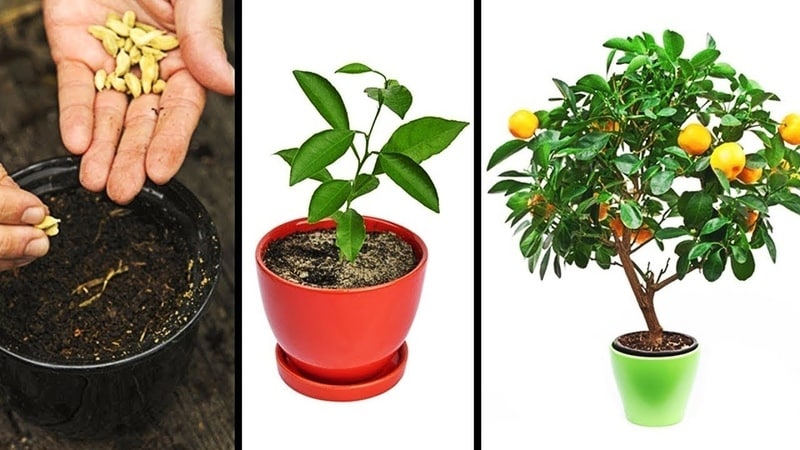
Pavlovsk lemon is propagated by generative and vegetative methods.
In the first case, reproduction occurs by seeds. From such planting material, more hardy plants are obtained that quickly develop and form correctly. They often have a beautiful shape even without regular cutting and shaping.
The disadvantage of this method is that lemons grown from seeds begin to bear fruit later (after 5-7 years). In this case, the shrub does not necessarily inherit the characteristics of the plant whose fruits were used. In this case, most likely, you will get Pavlovsk lemon and not wild lemon, but its fruits will be more sour and smaller.
Using the vegetative method, lemons are propagated by cuttings. This option allows you to get a harvest in the shortest possible time (in 3-4 years). The cuttings will bloom already 2 years after rooting.
Lemons grown from cuttings will produce large fruits with good taste. At the same time, the shrub is less resistant to negative environmental factors than specimens obtained from seed material.
In the case of Pavlovsk lemon, grafting is not necessary. It is done only if the tree grown from seed, refuses to bear fruit even 7 years after planting.
Note! Reproduction of Pavlovsk lemon is also possible through air layering. However, this method is rarely used due to the difficulty of obtaining planting material.
In both cases, preparation of containers and soil for lemons is required. The seeds are first sown in a common container, and after the formation of 2 leaves, they are planted in separate containers with a diameter of 5-8 cm. The cuttings are immediately rooted in a separate container with a diameter of 5-8 cm.
For lemon, purchase special soil for citrus fruits or prepare a soil mixture yourself. In the second case, mix 2 parts of garden soil, rotted (preferably horse) manure and humus with 1 part of sand. Add 1 tbsp to the bucket of the resulting mixture. ash, 30 g of superphosphate and 20 g of potassium fertilizer. This mixture is used for further cultivation of lemons.
Drainage is also necessary. Usually broken ceramics or bricks, expanded clay, and small crushed stone are used.
The soil, containers and drainage are disinfected. This is done using high temperatures (poured with boiling water, calcined in the oven) or disinfecting solutions (potassium permanganate, 1% copper sulfate).
Seeds
Seed material is collected from ripe fruits of Pavlovsk lemon of regular shape, without rot or traces of disease. The seeds themselves should be of a uniform light shade, dense, without stains or damage.
The collected planting material is prepared:
- Germination test. The bones are soaked in salted water. Seeds that float to the surface are unsuitable for planting. Use specimens that have sunk to the bottom.
- Disinfection. The seeds are soaked for 30-60 minutes.in “Fitosporin”, a light pink solution of potassium permanganate or hydrogen peroxide.
- Growth stimulation. Planting material is soaked for a day in a growth stimulator. They use purchased products (“Epin”) or folk recipes (aloe juice diluted in half with water).
It is recommended to sow more seeds than needed. Not all of them will germinate and take root after picking.
This is interesting! Some citrus growers remove the seeds from the hard shell before planting. This is done carefully so as not to damage the cotyledons. This procedure accelerates seed germination.
After preparation, start sowing:
- A 1 cm layer of drainage is poured into the bottom of the container. The rest of the volume is filled with soil. The soil is watered with warm water.
- Seeds are sown to a depth of 1 cm at a distance of 3-5 cm from each other and sprinkled with earth.
- The container with the crops is covered with film or transparent plastic and placed in a place with a temperature of +24...+25°C.
- Before the first shoots appear, the soil is regularly moistened, and the crops are ventilated, opening the greenhouse daily for 15-30 minutes.
- When the seeds sprout, they moisten not only the soil, but also the seedlings. The duration of ventilation is gradually increased.
- When 2 true leaves appear, the lemons are planted in individual containers filled with soil and drainage. The seedlings are not covered with film.
Cuttings
To obtain cuttings, choose a healthy tree that has already bear fruit. The branch from which the planting material will be cut must be no older than a year and have semi-lignified, green and elastic bark.
Step back 8-10 cm from the edge of the selected branch and make a cut at an angle. There should be at least 2-3 live buds left on the pruning. The leaves at the bottom of the cuttings are torn off. The top leaves are cut in half.
The cutting is first immersed for 30 minutes.into a light pink solution of potassium permanganate, and then for 1 day into a root formation stimulator (“Kornevin”).
Drainage is poured into the bottom of the container, and the rest of the volume is filled with soil. The cutting is stuck into the soil 2-3 cm so that it can stand even without support. The lemon is covered with a bag or a cut bottle.
The soil is watered daily and the lemon is sprayed with warm water. It is important to open the greenhouse slightly for ventilation every day for 15-30 minutes.
The rooting of the seedling will be indicated by awakened buds with developing shoots. After this, the duration of ventilation is gradually increased, and then the greenhouse is completely removed. The lemon is transplanted into a new larger pot when its roots fill the previous container.
Growing technology
Pavlova lemon requires care. When growing it, it is important to maintain optimal temperature in the room, ensure proper watering and timely application. feeding. Otherwise, the plant will not bloom and bear fruit, and in the worst case, it will simply die.
Optimal conditions
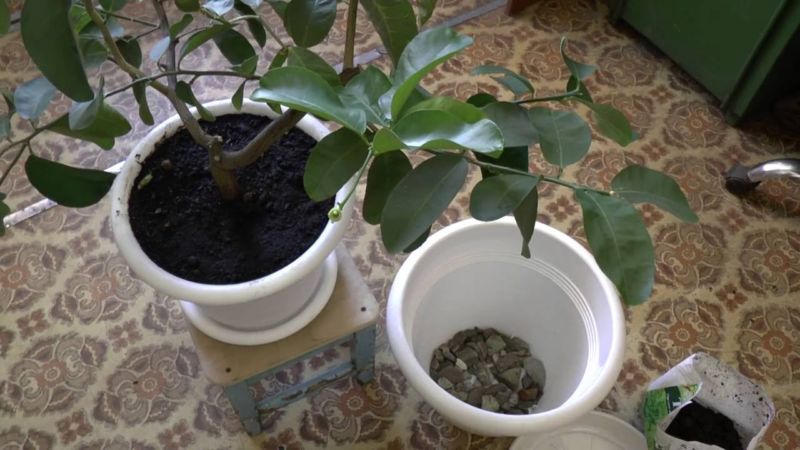
For lemon to feel good at home, it is important that the room meets the basic requirements:
- Temperature. In summer, spring and autumn, the optimal daytime temperature varies between +19…+26°C. In winter, temperatures should not exceed +21°C. To put the lemon into a state of rest, the temperature in winter is reduced to +10...+15°C. The plant does not tolerate sudden changes in temperature, so before bringing it into a colder or warmer room, the pot is taken out to new conditions every day, gradually increasing the time it stays there. A draft is also detrimental to culture.
- Humidity is maintained within 70-75%. During the hot season, the bush is sprayed with a spray bottle in the morning and evening; in the warm season, one spray per day is enough. In winter, if the lemon is in a heated room, place a humidifier or containers of water near it.
- Lighting. For normal fruiting and flowering, citrus trees must receive a sufficient amount of light, but direct sunlight is also harmful to them. In spring, summer and autumn, the plant is placed on the eastern, southern or western windowsill, covering the window with a translucent curtain during maximum solar activity. If the lemon bush is dormant in winter, it does not require additional lighting. If the plant overwinters in a warm room, phytolamps are installed at a distance of 20 cm from it.
Basic rules of care
Pavlovsk lemon must be regularly and properly cared for:
- Watering. In the warm season, lemon is watered daily, and in winter - 1-2 times a week. For irrigation, use warm, settled water (chlorine is harmful to the plant). After each watering, the soil is loosened. Water the lemon in the morning or evening when the sun is not active.
- Cleaning. Every week, wipe the lemon leaves with a damp cloth. Once a month, wash the plant in the shower, covering the soil with film.
- Transplants. For the first 3 years, the lemon is annually transferred (rearranged into a new pot along with a lump of earth, adding the missing soil) into a larger container. After the first fruiting, the plant is replanted once every 2-3 years, removing most of the soil and cutting off dead roots. When the bush reaches the desired size, replanting is stopped, annually replacing the top layer of soil with new soil.
- Feeding. They are applied weekly from early spring to late autumn.Alternate mineral and organic fertilizers.
- Formation. The growth point is cut off after the main trunk reaches 15-25 cm. The branches of the first, second, third, fourth and fifth order are shortened to 10-20 cm. 3-4 branches of each order are left on the tree.
- Bloom. Pavlovsk lemon can bloom 1-2 years after planting. Such flowering is called false - it does not produce fruit, but takes away the strength of the plant. Therefore, all inflorescences are removed. In the 3rd year, half of the inflorescences are removed. Further, do not interfere with the flowering of the lemon. To increase yield, it is recommended to carry out artificial pollination with a soft brush.
- Fruiting. During the first fruiting, no more than 3 ovaries are left on the plant. Further, the fruits are not picked. To speed up the ripening of lemons, water them with warm water near the stalk.
- Sanitary pruning. It is carried out in autumn or spring. In the process, all diseased, weak and dry shoots are cut off.
Possible problems
At home pests Lemons are rarely affected. To prevent damage by aphids, spider mites and scale insects, the plant is regularly inspected and washed in the shower. If necessary, treat with soap solution, decoction of bitter herbs or insecticides.
The risk of a lemon bush becoming infected at home is also low. Most often it is attacked by sooty fungus, root rot and gommosis. For prevention, it is important to follow the rules of care. Infected plants are treated with fungicides, preparations containing copper, or folk remedies with an antifungal effect, for example, iodine with milk.
Note! If the rules of care are violated, the Pavlovsk lemon sheds its leaves.
Harvesting and application
The harvest is harvested when the lemons become large and turn yellow (see photo).photo). The fruits are cut together with the stalk.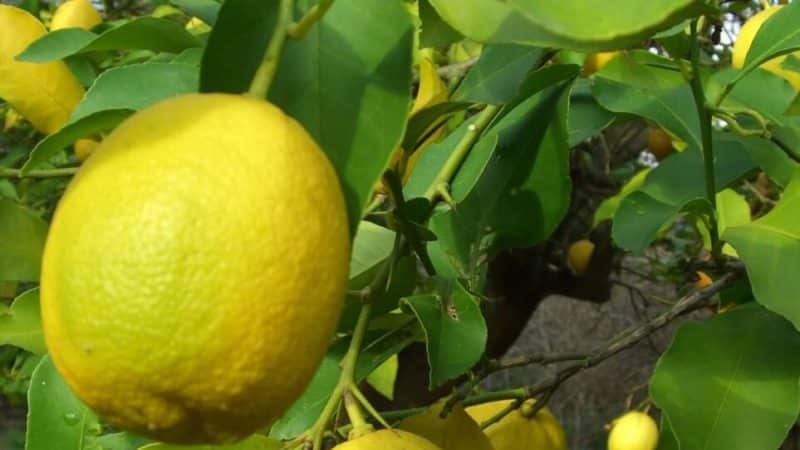
It is important to harvest in a timely manner. If you keep the fruits on the bush, their taste will become less intense and the pulp will become coarse.
Reviews
Reviews from citrus growers about Pavlovsk lemon are mostly positive. Although professionals say that there are more tasty and hardy varieties that are suitable for growing at home.
Victor, Moscow: “I’ve been growing Pavlovsk lemon on the windowsill for about 7 years now. I started producing fruits already in the third year, but so far no more than 5 pieces are formed. for 1 time. The plant is capricious to care for. Without formation, it begins to grow parallel to the windowsill and does not produce shoots of the 4th and 6th order, which bear fruit. To achieve fruiting, I replant every 2 years into a narrow, high container and mercilessly cut off everything that grows incorrectly. The taste of the fruit is satisfactory.”
Irina, Sochi: “Pavlova lemon is my very first citrus. He is already 15 years old. Now I have several other varieties. And despite the fact that Pavlovsky is the ugliest of them all, I love him more than others. Every year it produces about 10 large and tasty fruits. It is demanding in terms of care, but if you are not lazy, it produces stable fruit.”
Conclusion
Pavlovsk lemon is one of the first citrus fruits brought to Russia. Over more than 100 years of existence in our country, it has undergone many changes, becoming more tasty and hardy.
Gardeners agree that there are many varieties that bear fruit with no less regularity, but at the same time are less demanding in care. Despite this, Pavlovsk citrus remains popular due to its large and tasty fruits.
I purchased seedlings of Pavlovsk lemon and was very pleased.At the beginning I was tormented by doubts whether I could trust them, but all my doubts turned out to be in vain when the plants arrived. Everything was well packaged, the seedlings were in good condition. They sent it right away, to the Urals in four days, great job. I definitely recommend it to anyone who needs seedlings from this nursery; you can’t go wrong.
Valery Ivanovich